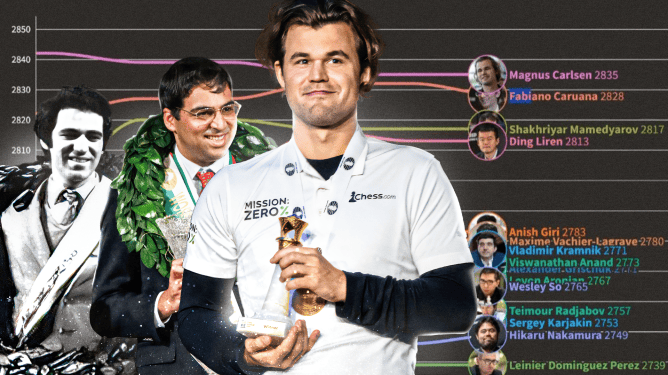For more than 50 years now, chess players have been statistically rated and ranked based on their record of wins, losses, and draws. These ratings give us a nice set of historical statistical data to use for various purposes. Sometimes, that purpose is just to watch them change in the flow of time, and to that effect Chess.com presented a video of the top women players over time back in July. Today, we bring you the top players, period.
You may also enjoy our previous data visualizations of the most accurate chess players over time and the countries with the most grandmasters over time.
Methodology
The basis of the video is the active top 10 FIDE rating list, which has been published at least once a year since 1970. Players make their first appearance in the visualization when they reach the top 10, and fall off after permanently losing that status.
Exceptions are made in the cases of GMs Bobby Fischer, Garry Kasparov, and Vladimir Kramnik. They all retired while still in the top 10 (at #1 in the case of Fischer and Kasparov) and remained on the active rating list for a year, but are removed here immediately after their final rating change. In Fischer’s case, with no list after the start of the World Championship in July 1972 until a year later in July 1973, he still remains for some time in order to capture his full performance. And yes, even though Fischer won seven games and lost just two (and forfeited a third) in the entire match vs. Spassky, it only earned him five extra rating points as he went from 2780 to 2785.

Kasparov has played a few rapid and blitz events but no rated classical game since 2005. Photo: Maria Emelianova/Chess.com.
After periods of biannual, quarterly, and bimonthly releases, the list finally moved to monthly in 2012. Players remain on the graph until permanently falling below top-10 status.
Just like in the video about the top women over time, data between lists was interpolated to create an uninterrupted monthly chart. The lists were again from OlimpBase through 1999 and from FIDE from 2000 onward.
Trends & Observations
Yes, Fischer was that much better than the opposition at his peak. How long he could have sustained that dominance against the next generation is a different question. Even when GM Anatoly Karpov peaked at 2780 in 1994, as rating inflation had reached a point where that still left him as number two in the world behind Kasparov, he was also just shy of Fischer’s career high. So perhaps a healthy Fischer does keep it going for a long time.

Fischer had no institutional support compared to Soviet grandmasters, and still beat them all by 1972. Photo: © Alamy.com.
Karpov’s number-one status was threatened by Korchnoi for several years, but Karpov took care of that for good with an easy win in the 1981 World Championship. Kasparov caught him before their first world championship in 1984, fell back behind during it, then took number one back from Karpov and kept it until his retirement—although Kramnik managed to tie him on one list in 1996.
The period between Kasparov’s retirement and Carlsen permanently claiming number one in 2011 was a free-for-all including Kramnik, GM Viswanathan Anand, GM Veselin Topalov, and Carlsen himself in the top spot. Carlsen’s lead has oscillated between a high of 72 points in the summer of 2014 and a low of three in late 2018 when he was battling GM Fabiano Caruana to retain the world championship.

Carlsen in 2019, near the second peak of his still-ongoing run as the world number-one. Photo: Maria Emelianova/Chess.com.
What it takes to be a top-10 player is also interesting. When the video starts, GM Mikhail Tail is in 10th at a 2590 rating. It doesn’t take long for ratings in the 2500s to disappear for good. However, it is not until the 2010s when ratings in the 2600-2699 range disappear. With rating deflation now a larger concern than inflation, the top 10 occasionally dips below 2750, but it is incredibly unlikely that there will ever again be fewer than 10 players rated 2700.


